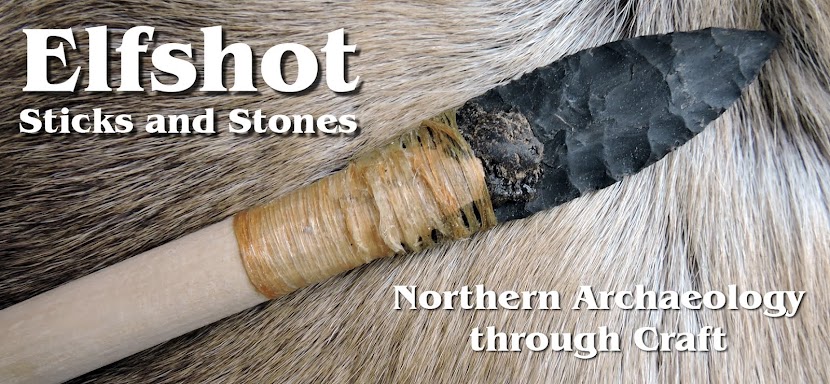 |
| Skilled knappers |
This morning I was reviewing and photographing some of the Groswater Palaeoeskimo collections from Bird Cove at The Rooms. When it came to toolmaking, Palaeoeskimos in general were a pretty stylish bunch and the Groswater in particular were meticulous craftspeople. These were the folks who left the carefully made harpoon shaft in the bog at
L'Anse aux Meadows almost 3,000 years ago and over 1,000 years later they were still making their jewel-like tools at Bird Cove and other sites around Newfoundland.
 |
| Fine grained, colourful endblades |
One of the papers that I'm working on this fall is about the very late Groswater Palaeoeskimo occupation at a Bird Cove site called Peat Garden. Latonia Hartery and I excavated there for several years a decade ago. The article that we're working on will be describing the Groswater component, focusing on the very late radiocarbon dates from the site, which extends the Groswater Palaeoeskimo occupation in Newfoundland by perhaps 150 or 200 years, to as late as 1750 BP.
 |
| Self-bladed, open socket Groswater Palaeoeskimo Harpoon Head from Peat Garden |
 |
| We found dozens of these little scrapers |
Its been a long time since I viewed the Bird Cove material and I had a fascinating visit with the artifacts this morning. The artifacts haven't changed in the past 10 years, but I definitely see them differently now. On the one hand, they are very familiar. I was working at Bird Cove at the same time that I was getting Elfshot off the ground, so I used a lot of the artifacts that we were finding as the source material for many of the reproductions and jewelry that I've been making ever since. On the other hand, I've worked on a lot more sites and with other collections since then, so the little quirks in the collection that make it unique pop out a bit more now. In my opinion, its hard to find a dull Groswater site, but hopefully the those little quirks in the Peat Garden material, combined with the very late dates, will make an especially interesting paper.
 |
| The square block is an abrading stone |
One of the traits that shows up at Groswater Palaeoeskimo sites is grinding on knapped chert tools. Blanks were initially knapped and then ground flat with small hand held abrading stones. At Peat Garden, grinding is used exclusively on burin-like tools and side knives/side scrapers, but elsewhere its used on other sorts of tools, like endblades and knives to prepare a surface for a final perfect series of parallel pressure flakes. Its a trick that modern flintknappers still use called "flake over grinding" or FOG knapping to create a perfect jewel-like finish on a knapped point. It takes time today to grind a blank smooth and flat using diamond abrading wheels, imagine the hours that Groswater knappers spend grinding away by hand with their sandstone abraders.
At Peat Garden, the Groswater Palaeoeskimo knappers continued to grind and knap their BLTs and Side-scrapers throughout the life of the tool. Look at the little burin-like tool on the far right in the photo below - see how the the top is ground thinner than the base - that's because it continued to be ground and resharpened while it was hafted in the handle.
 |
| Peat Garden Artifacts: A sequence of Groswater Palaeoeskimo burin-like tools, from a complete un-ground blank on the left through to a tiny, used up nubbin on the right. The white patches are areas that have been ground flat. |
Photo Credits: Tim Rast







No comments:
Post a Comment